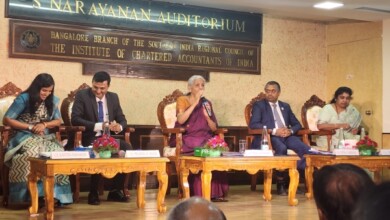Hazardous Chemicals in Underground Water

The Government is aware of the presence of various hazardous chemical contents in ground water at some places in the country. However, Central government has taken a number of initiatives in collaboration with States to provide safe water to the citizens.
Central Ground Water Board (CGWB) generates ground water quality data of the country on a regional scale as part of its ground water quality monitoring program along with various scientific studies.
CGWB studies indicate the occurrence of contaminants such as Flouride, Arsenic, Nitrate, Iron and heavy metals beyond permissible limits (as per BIS) for human consumption in isolated pockets in various States / UTs. The ground water contamination reported by CGWB is mostly geogenic in nature and does not show significant change over the years. However, nitrate contamination is mostly anthropogenic and its spread has been noticed in some areas, particularly areas adjoining habitations. Nitrate contamination may also be caused by excessive use of fertilizers. State-wise details of contamination of ground water are given at Annexure.
Government of India in partnership with States, is implementing Jal Jeevan Mission (JJM) since August, 2019 to provide potable tap water supply of prescribed quality to every rural household in the country by 2024. Under JJM, while planning water supply schemes to provide tap water supply to households, priority is given to quality–affected habitations. While allocating the funds to States/ UTs in a particular financial year, 10% weightage is given to the population residing in habitations affected by chemical contaminants including Arsenic and Fluoride, as on 31st March of the preceding Financial Year.
Since, planning, implementation and commissioning of piped water supply schemes based on a safe water source likely to take time, States/ UTs have been advised to install community water purification plants (CWPPs) in such habitations, purely as an interim measure, to provide potable water to every household at the rate of 8–10 litre per capita per day to meet their drinking and cooking requirements.
Central Pollution Control Board (CPCB) in association with State Pollution Control Boards/Pollution Control Committees (SPCBs/PCCs) is implementing the provisions of The Water (Prevention & Control) Act, 1974 & The Environment (Protection) Act, 1986 to prevent and control pollution in water.
Under Atal Mission for Rejuvenation and Urban Transformation (AMRUT) launched on 25th June, 2015 in selected 500 cities with focus on development of urban infrastructure in various sectors including water supply. States/UTs have the option to take projects on special water supply arrangements for difficult areas, hill and coastal cities, including those having water quality problems with Arsenic, Fluoride etc.
Under the National Aquifer Mapping Programme (NAQUIM) of CGWB, special attention is being given to the aspect of ground water quality including contamination by toxic substances such as Arsenic in ground water.
CGWB has constructed several exploratory and observation wells in the Country tapping the Arsenic safe deeper aquifer zones delineated through exploration aided detailed aquifer mapping under National Aquifer Mapping programme. Successful wells have been handed over to the State Governments for their purposeful utilization. Further, CGWB is providing technical assistance to the States by sharing the cement sealing technology for tapping contamination free aquifers in Gangetic flood plains.
This information was given by the Union Minister for Jal Shakti, Shri Gajendra Singh Shekhawat in a written reply in Rajya Sabha today.
*****
AS/SK
Annexure
States Wise Number of Partly Affected Districts with different Contaminants in Ground Water of India
| S. No. | State/ UT | Salinity (EC above 3000 micro mhos/ cm) (EC : Electrical Conductivity) | Fluoride (above 1.5 mg/l) | Nitrate (above 45 mg/l) | Arsenic (above 0.01 mg/l) | Iron (above 1mg/l ) | Lead (above 0.01 mg/l)
| Cadmium (above 0.003 mg/l)
| Chromium (above 0.05 mg/l) |
| 1 | Andhra Pradesh | 12 | 12 | 13 | 3 | 7 | |||
| 2 | Telangana | 8 | 10 | 10 | 1 | 8 | 2 | 1 | 1 |
| 3 | Assam | 9 | 19 | 18 | |||||
| 4 | Arunachal Pradesh | 4 | |||||||
| 5 | Bihar | 13 | 10 | 22 | 19 | ||||
| 6 | Chhattisgarh | 1 | 19 | 12 | 1 | 17 | 1 | 1 | 1 |
| 7 | Delhi | 7 | 7 | 8 | 2 | 3 | 1 | 4 | |
| 8 | Goa | 2 | |||||||
| 9 | Gujarat | 21 | 22 | 24 | 12 | 10 | |||
| 10 | Haryana | 18 | 21 | 21 | 15 | 17 | 17 | 7 | 1 |
| 11 | Himachal Pradesh | 6 | 1 | ||||||
| 12 | Jammu & Kashmir | 2 | 6 | 3 | 9 | 3 | 1 | ||
| 13 | Jharkhand | 12 | 11 | 2 | 6 | 1 | |||
| 14 | Karnataka | 29 | 30 | 29 | 2 | 22 | |||
| 15 | Kerala | 4 | 5 | 11 | 14 | 2 | 1 | ||
| 16 | Madhya Pradesh | 18 | 43 | 51 | 8 | 41 | 16 | ||
| 17 | Maharashtra | 25 | 17 | 30 | 20 | 19 | |||
| 18 | Manipur | 1 | 2 | 4 | |||||
| 19 | Meghalaya | 1 | 6 | ||||||
| 20 | Nagaland | 1 | 1 | ||||||
| 21 | Odisha | 17 | 26 | 28 | 1 | 30 | 1 | ||
| 22 | Punjab | 10 | 19 | 21 | 10 | 9 | 6 | 8 | 10 |
| 23 | Rajasthan | 30 | 33 | 33 | 1 | 33 | 3 | ||
| 24 | Tamil Nadu | 28 | 25 | 29 | 9 | 2 | 3 | 1 | 5 |
| 25 | Tripura | 4 | |||||||
| 26 | Uttar Pradesh | 13 | 34 | 59 | 28 | 15 | 10 | 2 | 3 |
| 27 | Uttarakhand | 4 | 5 | ||||||
| 28 | West Bengal | 6 | 8 | 5 | 9 | 16 | 6 | 2 | 2 |
| 29 | Andaman& Nicobar | 1 | 2 | ||||||
| 30 | Daman & Diu | 1 | 1 | 1 | |||||
| 31 | Puducherry | 1 | |||||||
| Total | Parts of 249 districts in 18 states & UTs | Parts of 370 districts in 23 states & UTs | Parts of 423 districts in 23 states & UTs | Parts of 152 districts in 21 states & UTs | Parts of 341 districts in 27 states & UTs | Pb in parts of 92 districts in 14 states
| Cd in parts of 24 districts in 9 states
| Cr in parts of 29districts in 10 states
|




